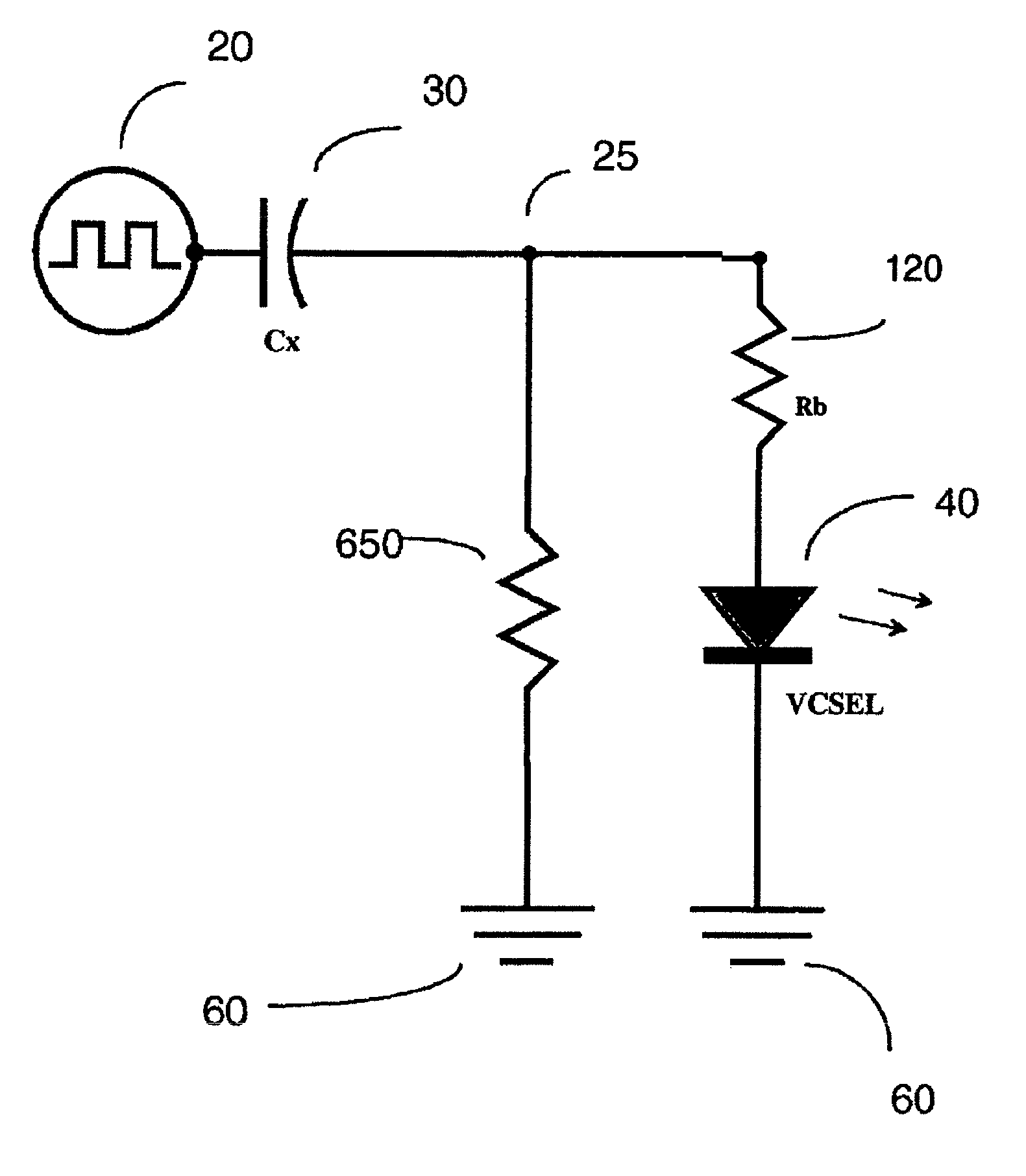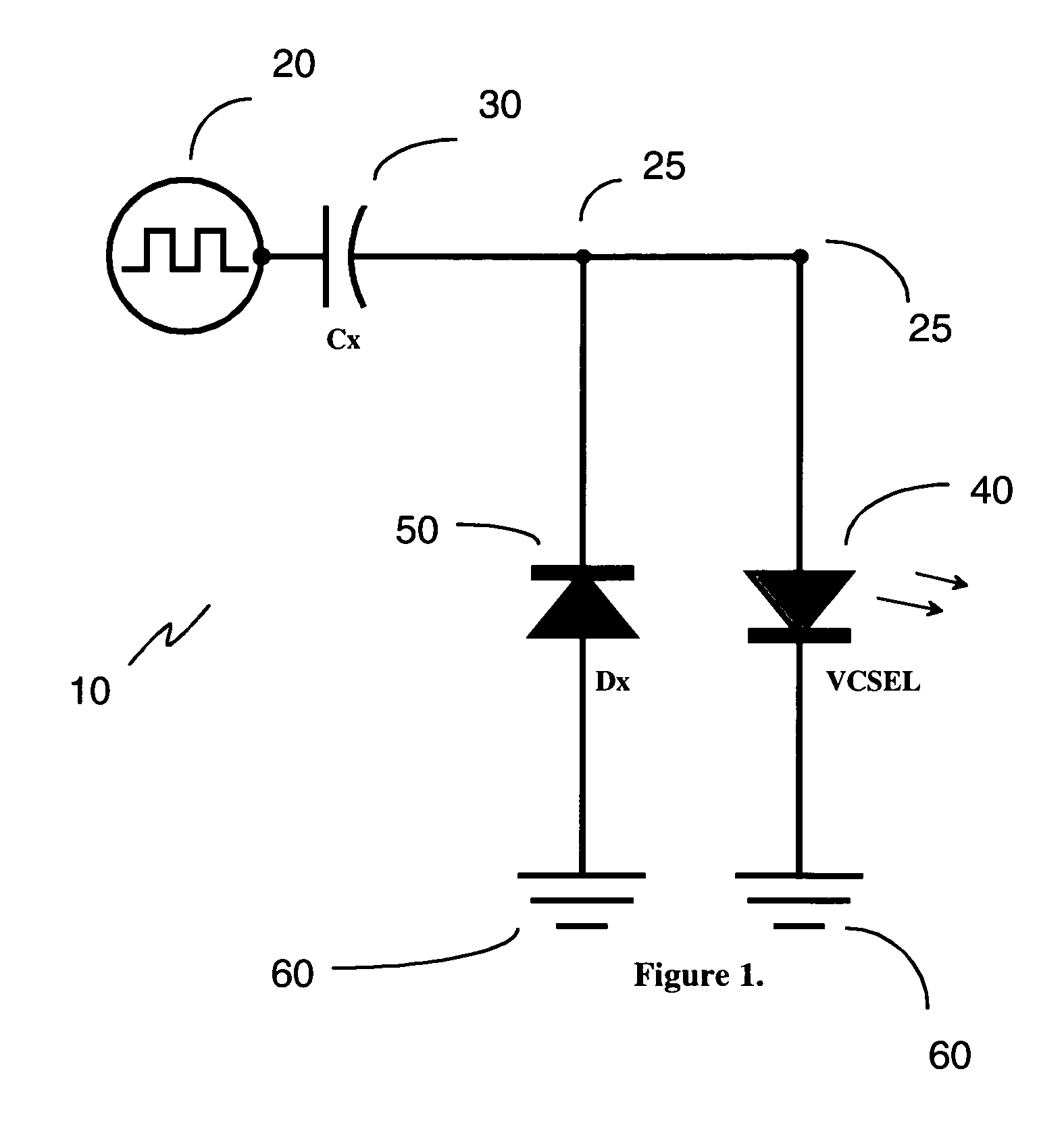Low power optical interconnect driver circuit
a driver circuit and low power technology, applied in static indicating devices, instruments, electroluminescent light sources, etc., can solve the problems of increasing the cost of the system even more, increasing the cost of the system, and prohibiting traditional optical data links, so as to reduce the power dissipation and reduce the load burden on the driving input signal, the effect of low capacitance values
- Summary
- Abstract
- Description
- Claims
- Application Information
AI Technical Summary
Benefits of technology
Problems solved by technology
Method used
Image
Examples
embodiment 10
[0032]An embodiment 10 of the driver circuit of this invention for driving a light emitting semiconductor device (a VCSEL in the embodiment shown) is shown in FIG. 1.
[0033]Referring to FIG. 1, the embodiment 10 of the driver circuit of this invention includes a capacitor 30 connected between a source of voltage pulses 20 and a terminal 25 of the light emitting semiconductor device 40 (a VCSEL 40 in the embodiment shown), the light emitting semiconductor device 40 being connected so that a forward current flow direction of the light emitting semiconductor device (indicated by the pointed portion of the symbol used to represent the light emitting semiconductor device 40) is away from the terminal 25, and, a diode 50 connected in parallel to the light emitting semiconductor device 40. The diode 50 is connected so that a direction of forward current flow of the diode 50 is opposite to the forward current flow direction of the light emitting semiconductor device 40. In the embodiment sho...
embodiment 100
[0036]The embodiment 100 of the driver circuit of this invention, shown in FIG. 2, includes a resistor 110 connected in series with the capacitor 30 (Cx) and / or another resistor 120 connected in series with the light emitting semiconductor device 40, the diode 50 being connected in parallel with the series combination of other resistor 120 and the light emitting semiconductor device 40. Circuit functionality is unchanged but this embodiment can allow for additional tailoring of duration and magnitude of the pulse currents. In certain applications it may be desirable to tailor capacitor charge rates to allow a greater range of capacitor values and limit current / voltage rise rates (thereby altering the pulse shape of the optical emission).
embodiment 200
[0037]The embodiment 200 of the driver circuit of this invention shown in FIG. 3 includes two light emitting semiconductor devices 210, 220 (VCSEL devices in the embodiment shown) wired in parallel and having opposite polarities (also referred to as one light emitting semiconductor device 210 and the other light emitting semiconductor device 220 are located, positioned or oriented such that a direction of forward current flow of the one light emitting semiconductor device 210 is opposite to the forward current flow direction of the other light emitting semiconductor device 220) allowing one semiconductor device to emit radiation at the rising edge of the input signal and the other to emit radiation at the falling edge of the input signal. The capacitor 30 charges through one light emitting semiconductor device (VCSEL) 210 and discharges through the second light emitting semiconductor device (VCSEL) 220. In this embodiment, the second light emitting semiconductor device (VCSEL) 220 r...
PUM
 Login to View More
Login to View More Abstract
Description
Claims
Application Information
 Login to View More
Login to View More - R&D
- Intellectual Property
- Life Sciences
- Materials
- Tech Scout
- Unparalleled Data Quality
- Higher Quality Content
- 60% Fewer Hallucinations
Browse by: Latest US Patents, China's latest patents, Technical Efficacy Thesaurus, Application Domain, Technology Topic, Popular Technical Reports.
© 2025 PatSnap. All rights reserved.Legal|Privacy policy|Modern Slavery Act Transparency Statement|Sitemap|About US| Contact US: help@patsnap.com



